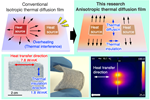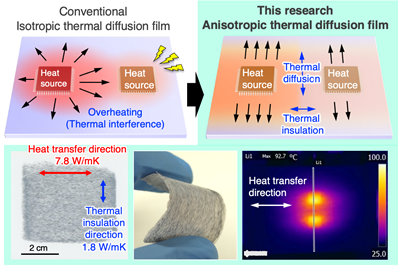ORNL carbon nanofibers yield fiber-matrix interfacial bond improvement
Through a novel electrospinning technique, researchers have effectively achieved a “bridge” between carbon fiber and its matrix, creating stronger, tougher composites and opening new applications.
A carbon fiber is prepared for mounting in a device to test its adhesion to a polymer matrix. ORNL researchers are using polymer nanofibers to increase the adhesion, and thus the performance, of carbon fiber composites. Source (All Images) | Carlos Jones/ORNL, U.S. Dept. of Energy
Researchers at the U.S. Department of Energy (DOE)’s Oak Ridge National Laboratory (ORNL) have announced development of a novel technique using carbon nanofibers to enhance binding in carbon fiber and other fiber-reinforced polymer (FRP) composites. The results, published in , may open new options for U.S. manufacturers to use carbon fiber in applications such as energy and national security.
“The challenge of improving adhesion between carbon fibers and the polymer matrix that surrounds them has been a concern in industry for some time, and a lot of research has gone into different approaches,” explains Sumit Gupta, the ORNL researcher who led the project. “What we found is that a hybrid technique using carbon nanofibers to create chemical and mechanical bonding yields excellent results.”
Carbon fiber is a type of composite in which strands of pure carbon are embedded in a polymer matrix. The challenge is that the matrix polymer does not cling strongly enough to the carbon fiber, reducing the performance of the composite material. To improve the fiber-matrix interfacial bond, industry has tried texturing the exterior of the fibers or injecting chemicals into the process — though with limited success, according to ORNL.
The ORNL approach, however, combines both mechanical and chemical bonding to yield a 50% improvement in tensile strength and a nearly two-fold increase in toughness, essentially the durability of the material, through use of carefully tailored nanofibers.
“We developed this process in 2023 but have been focused lately on optimizing it and fully understanding the physical processes that enable these improvements,” says ORNL researcher Chris Bowland. “We found that by carefully controlling multiple variables, we can create nanofibers that greatly enhance the performance of carbon fiber composites and potentially other types of composites.”
ORNL researchers Sumit Gupta and Chris Bowland inspect carbon fiber materials as part of their effort to improve the performance of composite materials.
The key to the improvements is a technique known as electrospinning, in which a carbon fiber precursor, polyacrylonitrile (PAN), is extruded into fibers. The PAN is extruded through a strong electric field to produce strands about 200 nanometers wide, or one-hundredth the width of a typical human hair. The strands land on a spinning metal drum overwrapped with carbon fiber fabric.
By varying the strength of the electric field, the speed of the drum and other factors, ORNL researchers can create fibers that chemically bond to the matrix and mechanically bond to other carbon fibers, essentially creating “bridges” between the two dissimilar materials. The researchers were also able to control the types of chemical bonding and the orientation of the fibers by tweaking the electrospinning conditions.
Learn more about the that has supported this nanofiber research.
To ensure the new technique is as impactful and flexible as possible, the team wanted to deeply understand the forces at play at the most fundamental levels. They first turned to ORNL’s Center for Nanophase Materials Sciences, a DOE Office of Science user facility, and its vast array of characterization and imaging tools. These tools enabled the researchers to see what was happening at the sub-micron level. They also used techniques such as X-ray scattering and nuclear magnetic resonance (NMR) imaging to understand how the fibers and matrix interact. Finally, they accessed the Frontier supercomputer at the Oak Ridge Leadership Computing Facility, a DOE Office of Science user facility, to fully model and simulate how the fibers form and interact with the matrix.
The ORNL research team has also applied for a patent on the technique and plans to seek out industrial partners to license the approach in hopes of improving the competitiveness of commercial carbon fiber composites. In the meantime, they plan to continue refining the electrospinning technique to provide greater control and better results while exploring potential applications for other fiber-reinforced composites. Ongoing research is looking into integrating the new technique with prior research on developing self-sensing composites that can monitor health through embedded particles of semiconducting or piezoelectric materials.
The research was sponsored by the DOE Office of Energy Efficiency and Renewable Energy’s Vehicle Technologies Office and Wind Energy Technologies Office, as well as the DOE Office of Science.
For related content, read “ORNL nanofibers research strengthens bridge between fiber, matrix” released in June 2024.
Related Content
Plant tour: Teijin Carbon America Inc., Greenwood, S.C., U.S.
In 2018, Teijin broke ground on a facility that is reportedly the largest capacity carbon fiber line currently in existence. The line has been fully functional for nearly two years and has plenty of room for expansion.
Read MoreBladder-assisted compression molding derivative produces complex, autoclave-quality automotive parts
HP Composites’ AirPower technology enables high-rate CFRP roof production with 50% energy savings for the Maserati MC20.
Read MoreWelding is not bonding
Discussion of the issues in our understanding of thermoplastic composite welded structures and certification of the latest materials and welding technologies for future airframes.
Read MorePlant tour: Airbus, Illescas, Spain
Airbus’ Illescas facility, featuring highly automated composites processes for the A350 lower wing cover and one-piece Section 19 fuselage barrels, works toward production ramp-ups and next-generation aircraft.
Read MoreRead Next
ORNL demonstrates lightning strike protection tech for composites
Researchers, led by Vipin Kumar, developed a low-cost, recyclable carbon fiber wind turbine blade tip that showed resilience to high-voltage lightning strikes, with more innovations in store.
Read MoreVacuum-assisted extrusion improves performance of FRP prints
A novel 3D printing approach developed by ORNL reduced internal porosity by up to 75% in large-scale, 3D printed composites.
Read MoreNanocomposite films boost heat dissipation in thin electronics
Scientists from Japan develop cellulose nanofiber-carbon fiber composite films with high in-plane heat conductivity to assist in heat dissipation in electronic devices.
Read More












